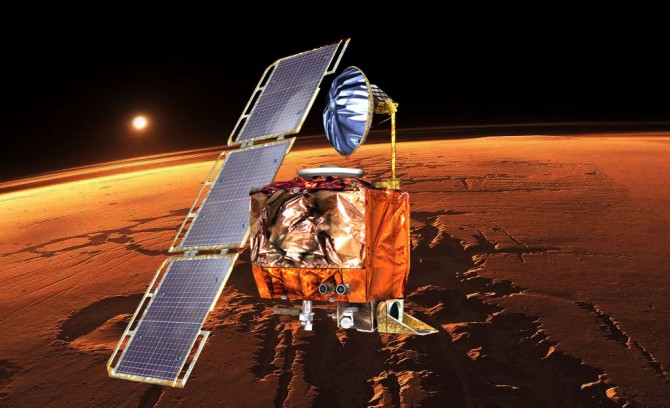Two NASA spacecraft launches, one to Mars and the other to research the birth of stars, involve Cornell astronomers' projects
By Blaine Friedlander
NASA launched the Mars Climate Orbiter today (Dec. 11, 1998) from Cape Canaveral, Fla. On board the spacecraft was the Mars Color Imager -- known as MARCI -- designed with the help of two Cornell University astronomers. Engineering problems had forced postponement of the launch from Dec. 10.
The mission marked the second scientific launch in the past week for Cornell researchers. On Saturday, Dec. 5, NASA launched the Submillimeter Wave Astronomy Satellite (SWAS) astronomical observatory from the belly of a modifed L-1011 aircraft.
Mars Climate Orbiter will monitor Mars' atmosphere and capture color images with MARCI for one Martian year, the equivalent of two Earth years. Mission scientists expect MARCI to capture images of Martian atmospheric dust and water vapor and to record seasonal changes.
James F. Bell, Cornell assistant professor of astronomy and a member of the imaging team says, "We will be doing many things with MARCI that haven't yet been done. For example, using high resolution color imaging, we'll be examining how Mars' past climate has been preserved in its rocks and minerals, much like you can learn about the Earth's geologic past by looking at the coloring and stratigraphy of the Grand Canyon or other similar structures. MARCI will fill a big gap between the spectacular black-and-white images being returned now from the Mars Global Surveyor mission and the coarser-resolution color data sent back by the Viking missions more than 20 years ago."
Peter Thomas, a Cornell senior research associate, also a member of the MARCI team, will use the camera to study the Martian dunes and other wind-related features on the red planet. These features also provide unique insights into the present and past climate of Mars.
Bell and Thomas also will be working with the MARCI science team to focus on detecting and tracking clouds, polar caps and dust storms that are part of the ever-changing planet's current but poorly understood climate. MARCI's wide-angle imaging mode will be used to return daily "weather maps" of Mars, similar to those obtained by Earth weather satellites.
Following a 10-month journey to the planet, the spacecraft will be "aerobraked" by low passes into the Martian atmosphere to allow it to get into a circular orbit around Mars. Bell expects the craft to begin sending data in late 1999 or early 2000. A major role for the spacecraft is to support its companion spacecraft, Mars Polar Lander, scheduled for launch early in 1999. In a month-long mission at the end of 1999, Mars Climate Orbiter will explore the Martian south polar cap.
In last Saturday's launch, rocket boosters took SWAS from the upper atmosphere into space, where this newest space-based astronomical observatory will study the heavens in a band called "submillimeter radiation," lying between the infrared and radio waves on the electromagnetic spectrum. Astronomers will study the conditions that lead to the birth of stars, a process now hidden deep within obscuring clouds of interstellar dust and gas.
"Although stars are the basic building blocks of the universe, little detail is known concerning how stars are formed," says Paul Goldsmith, Cornell astronomer and director of the National Astronomy and Ionosphere Center, managed by Cornell for the National Science Foundation. Goldsmith, who is a project co-investigator with Martin Harwit, Cornell professor emeritus of astronomy, notes that "even today, this vital process is among the least understood steps in cosmic evolution. SWAS will give astronomers critical information about conditions in regions that are, or will likely soon be, forming stars."
The SWAS observatory will orbit the Earth every 97 minutes and typically will observe three to five astronomical objects an orbit. The observed data will be stored in the spacecraft memory and relayed to a ground station twice daily and then relayed to SWAS Science Operations Center at Smithsonian Astrophysical Observatory in Cambridge, Mass., for analysis. The mission is designed to last two years.
Get Cornell news delivered right to your inbox.
Subscribe